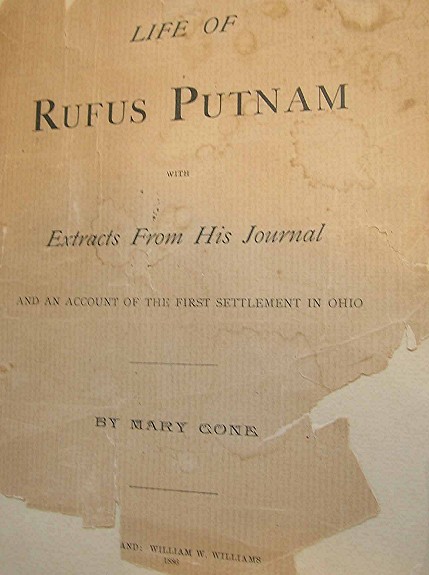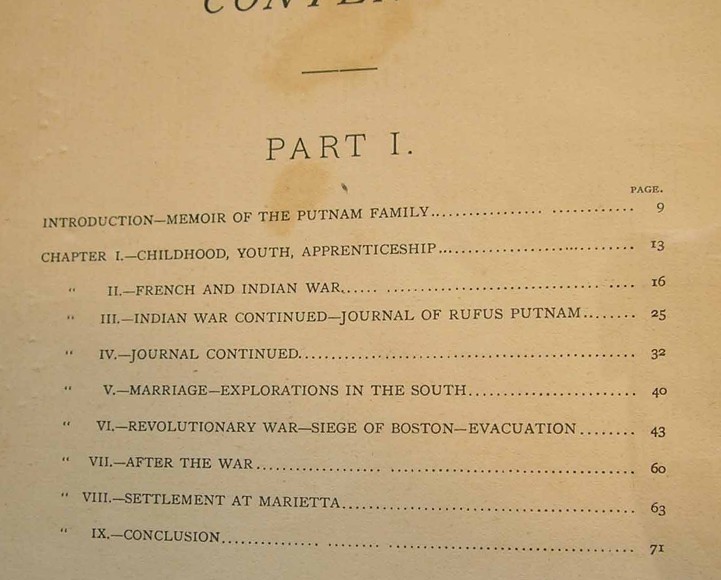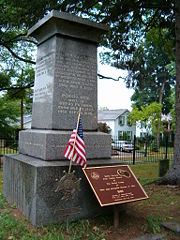MEMOIR OF THE PUTNAM FAMILY
- FIRST SETTLEMENT IN OHIO
Whether or not old Father Time moved with any greater swiftness in these latter days than he did in the centuries that are gone, events seem to thicken and more is accomplished. This great state of Ohio, which ranks as third in the grand Republic, a little than a century ago was a wilderness, teeming, to be sure, with riches, but had for inhabitants only the wild Indians, who did not know how to develop the vast resources wrapped up in a rich soil, wonderful forests hidden treasures of coal and iron, and oil to create light in dwellings and cause the busy wheels of machinery to run smoothly.
In the middle of the eighteenth century the Delaware Indians occupied nearly all of the eastern half of what is now the state of Ohio. The Chippewas were gathered around the southern shore of Lake Erie. The Ottawas occupied the valleys of the Maumee and Sandusky. The Shawanees were in the Scioto valley. The Miamis dwelt by the side of the rivers that bear their name. A part of the Wyandots, who the French called Mingoes, with the half-king had settled at the mouth of the Sandusky and the remainder at Detroit.
The Piquas were a branch of the Shawanees. These tribes were not, however, strictly confined to the territories mentioned. The Shawanees had a village called Logstown, seventeen miles below Pittsburgh, in the district of the Delawares. This last mentioned tribe had been driven from the Delaware to the Susquehanna, and from thence to the Allegheny, and again from there still further west until at last they settled down on the generous gift of the Wyandots.The boundary of this tract began at the Beaver river and extended to the Cuyahoga, and along Lake Erie to the Sandusky, up the Sandusky to the Hocking, down the Hocking to the Ohio.
The name, Delaware, is not Indian but came from the name of an early governor of Virginia, Lord De la War.Their own name for their tribe was Lenni Lenape, Indian for the Genesis term—man. By all the tribes mentioned, the Delawares seem to have been the most susceptible of civilization and the readiest to accept the Christian religion. It was among them that the self-sacrificing Moravians labored so successfully, and the victims who were the subjects of that saddest of sad stories, the massacre of the Christian Indians in Ohio, belonged to this tribe.
When the Revolutionary War began, it had been computed that the Indians of New York, Ohio and the lakes, would muster not less than ten thousand warriors. During the struggle between the northern country and the colonies, there were but few Indians that took sides with the colonies. The Iroquois, who had their principal seat in New York, were divided. The majority adhered to the British, while the Oneidas and Tuscarawas were induced to remain neutral, mainly through the influence of the missionary, Samuel Kirkland. In like manner the heroic and indefatigable Zeisberger for some time kept the Delawares from joining the ranks of the enemy. Thus on the western continent a zealous missionary held in check the Red men and kept them from the pillage and murder of the inhabitants, while the same important service was done in a similar way farther to the eastward.
This two-fold influence prevented a general rising of the Indians in the early part of the war, when the condition of things was most critical. It is true that later nearly all the Delawares went over to the British, but it was after the defeat of Burgoyne and the alliance made with France, when the Americans were better able to manage them. The capital of the Delawares and seat of their grand council was at the place where Newcomers-town is now situated. It was a large and flourishing Indian town containing one hundred houses, mostly built of logs.
The Iroquois in six nations held nominal sway over all these tribes, as well as many others still further west, claiming to own the country and the allegiance of the inhabitants by right of conquest.
When preparations were made for the company of the “Ohio country," there were but few settlements of the Indians found along the Ohio river. It was too easy for the powerful Iroquois to glide down its smooth current and attack their victims when unaware. There were no signs to announce their coming, and no tracks by which it could be ascertained whither they were going. The Delawares and other tribes had, therefore, retreated from the river and only came into the neighborhood thereof when in quest of game.
The award of greatest bravery was given to the Wyandots. It was a law among them to never surrender ; they must literally "conqueror die." In the battle of "the Fallen Timbers" only one chief of this tribe was taken prisoner, and he not until he was severely wounded.
The foundation (if the claims to this western country put forth by France and England has been already briefly considered in the life of General Putnam. It will suffice to repeat here that France based her claims on the right given by discovery and occupation. England claimed that discoveries and settlements on the Atlantic coast gave them a right to have and to hold all the territory on the same parallel from ocean to ocean. They also strengthened their cause by alleged treaties with and purchases from the Indians. But the treaties and purchases were alike contracted with the Iroquois, and their right to transfer the country in either way was disputed by the resident tribes. The difficulty between France and England culminated in the French and Indian war, which lasted from 1756 to 1763. A treaty of peace was made in Paris in 1763. In this treaty France ceded to England all her right and title to the country north and east of the Mississippi river. During the French occupation, what is now the state of Ohio was included in Louisiana. Subsequently, under English rule, it became a part of Canada. In 1774 parliament passed what is known as the "Quebec bill," by the provision of which the Ohio river was made the southwestern and the Mississippi the western boundary of Canada, thus including all of the northwest territory in the province of Quebec.
The English government did not seem to be in any haste to avail them- selves of the benefits of their new possessions. They did, however, build and fortify Fort Pitt. That point was too important to risk its loss.
In 1770 George Washington made a journey down the Ohio river.
Irving, in his 'Life of Washington,' gives the following account of the expedition:
Washington was one of the boaid of commissioners appointed at the close of the late war [French and Indian war] to settle the military accoimts of the colony, Among the claims which came before the board, were those of the officers and soldiers who had engaged to serve until peace, under the proclamation of Governor Dinwiddle, holding forth a bounty of two hundred acres of land, to be appor- tioned among them according to rank. Those claims were yet unsatisfied. . . . Washington became the champion of those claims, and an opportunity now presented itself for their liquidation. The six nations, by a treaty of 1768, had ceded to the British crown, in consideration of a sum of money, all the lands possessed by them south of the Ohio. Land offices would soon be opened for the sale of them. Squatters and speculators were already preparing to swarm in, set up their marks on the choicest spots and establish what were called pre-emption rights. Washington determined at once to visit the lands thus ceded, affix his mark on such tracts as he should select, and apply for a grant from government in behalf of the soldiers' claim.
The expedition would be attended with some degree of danger. The frontier was yet in an uneasy State, and the Mingoes complained that the Six Nations had not given them their full share of the consid- eration money of the late sale, and they talked of exacting the difference from the white men who came to settle in what had been their hunting grounds. Traders, squatters, and other adventurers into tlie wilderness were murdered, and further troubles were apprehended.
Washington had for a companion his friend and neighbor. Dr. Craik. They set out on the fifth day of October with their negro attendants, two belonging to Washington and one to the doctor. The whole party was mounted and there was a led horse for the baggage.
After twelve days' traveling they came to Fort Pitt. It was garrisoned by two companies of royal Irish, commanded by a Captain Edmonson. A hamlet of about twenty log houses inhabited by Indian traders, had sprung up within three hundred yards of the fort, and was called the town. It was the embryo city of Pittsburgli, now so prosperous. At one of the houses, a tolerable frontier inn, they took up their quarters, but during their brief sojourn they were entertained with great hospitality at the fort. . . .
At Pittsburgh the travelers left their horses and embarked in a large canoe, to make a voyage down the Ohio as far as the Great Kanawha. Colonel Croghan engaged two Indians for their service and an interpreter named John Nicholson. The colonel and some of the officers of the garrison accom- panied them as far as Logstown. Here they breakfasted together, the Colonel and his companions cheering the voyagers from the shore as the canoe was borne off by the current of the beautiful Ohio.
Washington's propensities as a sportsman had here full display. Deer were continually to be seen coming down to the water's edge to drink or browsing along the shore ; there were innumerable flocks of wild turkeys and streaming flights of ducks and geese, so that as the voyagers floated along, they were enabled to fill their canoe with game. At night they encamped on the river bank, lit their fire and made a sumptuous hunter's repast. The great object of his expedition is evinced in his constant notice of the features and character of the country ; the quality of the soil as indicated by the nature of the trees, and the level tracts fitted for settlements.
From other sources we get the following extracts from his journal:
At the lower end of the Long Reach, and for some distance up to it on the east side, is a large bottom, but low and covered with beach near the river shore, which is no indication of good land.
The Long Reach is a straight course of the river for about eighteen or twenty miles, which appears more extraordinary as the Ohio in general is remarkably crooked. There are several islands in this Reach, some containing a hundred or more acres of land, but all, I apprehend, liable to be overflowed.
October 26. — Washington, at night, encamped at a creek about twelve miles below these islands, which was pretty large at the mouth and just above an island.
The creek with the large mouth was the Little Muskingum. The journal continues:
October 27— Left our encampment a quarter before seven. After passing the creek near which we lay, and another of much the same size and on the same side [Duck Creek], also one island about two miles in length, but not wide, we came to the mouth of the Muskingum, distant from our encampment about four miles. This river is about a hundred and fifty yards wide at the mouth ; it runs out in a gentle current. It is a clear stream, and is navigable a great way into the country for canoes. From Muskingum to Little Kanawha is about thirteen miles. This is about as wide as the mouth of the Muskingum, but much deeper. It runs up towards the inhabitants of Monongahela. . . About six or seven miles below the mouth of the Little Kanawha, jve came to a small creek on the west side which the Indians call " Little Hockhocking." . . The land, for two or three miles below the Little Kanawha, appears to be broken and indifferent, but opposite to the Little Hockhocking there is a bottom of good land.
Washington seems never to have lost his interest in the western country, and his influence undoubtedly did much to direct thought and attention to the " Ohio country," when in the fullness of time prepara- tions were made for its occupation.
In 1774 the Shawnees became so hostile and aggressive, in consequence of the murder of the family of the celebrated Indian chief Logan, that it was necessary to take measures for their subjugation.
Lord Dunmore, the royal governor of Virginia, gathered together an army and went against them. He commanded in person the larger divi- sion of the army ; but entrusted a division of about eleven hundred to the command of General Andrew Lewis. This force was attacked by the Indians October 10, and then was fought one of the most sanguinary battles known in the warfare of the west. This engagement is known as the battle of Point Pleasant. The opposing ranks were about equal in number. Half the officers and fifty-two men were slain in General Lewis' division, while the loss of the Indians was supposed to be two hundred and thirty-three. Lord Dunmore was more fortunate. He was not attacked, and continued his march to Pickaway plains, where he met the remnant of the division that had suffered so disastrousl)'. At camp Charlotte, where the Indians were summoned to appear, they met Lord Dunmore, and all but Logan signed a treaty of peace. He did not re- spond to the summons to attend the meeting. When Lord Dunmore sent a messenger to him he sent, as an answer to the request to meet him, the speech so well known. Doubts have been cast upon its authenticity. But Jefferson and others, who had good opportunities for knowing, de- clared that there was no doubt as to its being authentic. Ziesberger, who knew Logan well, said that he (Logan) was quite capable of producing it. As a specimen of Indian eloquence it is worthy of repetition:
I appeal to any white man to say that he ever entered Logan's cabin but I gave him meat ; that he ever came naked but I clothed him. In the course of the last war Logan remained in his cabin, an ad- vocate for peace. I had such affection for the white people, that I was pointed at by the rest of my nation. I should have ever lived with them had it not been for Colonel Cresap, who last year cut off in cold blood all the relations of Logan, not sparing the women and children. There runs not a drop of my blood in the veins of any human creature. This called on me for revenge. I am glad that there is a prospect of peace, on account of the nation ; but I beg you will not entertain a thought that anything I have said proceeds from fear ! Logan disdains the thought ! He will not turn on his heel to save his life! Who is there to mourn for Logan? No one.
So far as the west was concerned, the most important event that occurred during the Revolutionary war, was the expedition and subsequent conquests of George Rogers Clark. He captured the British forts of Kaskaskia and St. Vincents, and thereby laid the foundation for the claim made by the United States, in the treaty of 1783, that their western boundary should extend to the Mississippi river. General Garfield said: "The cession of that great territory was due mainly to the foresight, the courage and endurance of one man, who never received from his country an adequate recognition of his great services."



